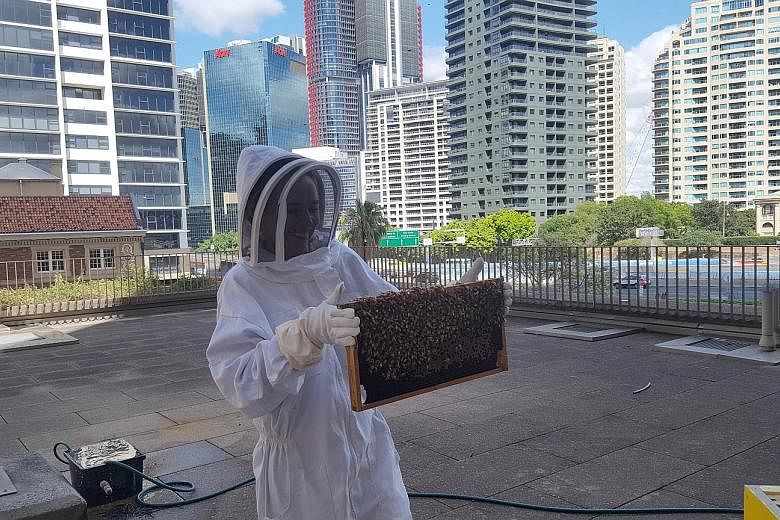It was one of the most successful crowdfunding projects in history: a new way of collecting honey from bees, which aimed to raise A$70,000 (S$74,260) and instead raised about A$16 million.
But the Flow Hive, which collects honey without requiring beekeepers to handle the bees and risk being stung, was not just an entrepreneurial success. The device, invented in Australia, has also led to a boom in beekeepers attracted by the option of keeping bees without much of the usual trouble.
Beekeeping clubs have been opening and growing across Australia, partly to make honey and to encourage the survival of bees, which are under global threat from disease.
The community clubs run workshops and help people acquire hives and keep them healthy.
Ms Vicky Brown, co-founder of The Urban Beehive, which runs beekeeping courses in Sydney, said the Flow Hive helped encourage a new wave of amateur beekeepers, including people who may previously have feared handling the insects.
"I think it brought a lot of awareness to beekeeping," she told The Straits Times.
"It got a lot of people involved in maintaining and caring for bees. People who were put off saw it as an alternative."
Ms Brown said she helps to run weekly courses for about 10 people and that an average of 30 per cent own Flow Hives. The remainder use traditional beekeeping equipment.
Australia is believed to be one of the last regions free of the Varroa mite, a tiny insect which - along with pollution and various diseases - has caused colony collapses around the world.
This has prompted growing interest in beekeeping, which comes amid concerns about the need to grow food locally, and in developing healthy bee populations to assist with pollination.
In Australia, people typically must register to be a beekeeper. There are 20,801 registered beekeepers managing 647,000 hives, according to ABC News.
In the state of New South Wales (NSW), beekeepers, whether amateur or commercial, must register and pay a fee of A$60 for two years or A$100 for businesses. Applicants must promise to report any diseases and to avoid causing any nuisance to others.
The state has about 6,400 registered beekeepers - a number that has almost doubled since 2015.
NSW's Minister for Primary Industries Niall Blair, whose department oversees bee registrations, recently revealed that he, too, is a beekeeper and has three hives which he tends with his 14-year-old son.
"I think it's fantastic thing to teach him," Mr Blair told The Sydney Morning Herald.
"He extracts the honey and we give it away or he sells it for pocket money. I'm really excited about the growth in the sector, because obviously bees are vitally important."
Ms Brown likened beekeeping to keeping a pet, saying owners end up with honey and beeswax which they tend to use themselves, sell or give away. She said owners of Flow Hives still need to learn how to identify diseases and to ensure the queen remains healthy.
"We give people hands-on experience to recognise how a beehive populates itself and how to identify diseases and how to harvest honey," she said.
The Australian Honey Bee Industry Council said some beekeeping clubs had doubled their membership since the Flow Hive emerged, and new clubs were opening.
"In Victoria, I know a couple of the clubs have put caps on their membership, because they were getting too many enquiries," the council's executive director Trevor Weatherhead told ABC News.
The Flow Hive has been a remarkable phenomenon, selling some 48,000 units across 130 countries. More than half have been bought by starter beekeepers.
It is the brainchild of Mr Cedar Anderson, 35, and his father Stuart, 60, amateur inventors who spent a decade creating it.
The device consists of artificial honeycomb cells in which the bees can leave honey before sealing the cells with wax.
A lever then splits the wax and turns the cells to create channels for the honey to flow out via a tap into a drum or jar below.
Flow Hive was launched on the crowdfunding site Indiegogo in 2015 and passed its goal of A$70,000 in five minutes, eventually receiving contributions from 116 countries.
Mr Stuart Anderson said he hoped the device attracted more people to beekeeping because "we need more bees".
"We hope it will attract young people and those in urban and suburban areas to take up beekeeping and, in turn, increase the bee population worldwide," he said in comments on the Flow Hive website.
Jonathan Pearlman


